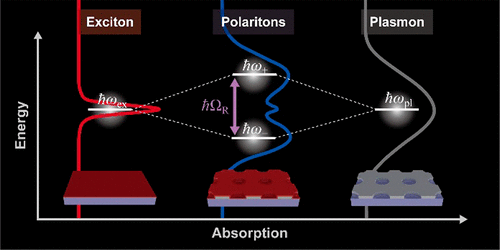当前位置:
X-MOL 学术
›
ACS Photonics
›
论文详情
Our official English website, www.x-mol.net, welcomes your
feedback! (Note: you will need to create a separate account there.)
Strong Plasmon–Exciton Coupling with Directional Absorption Features in Optically Thin Hybrid Nanohole Metasurfaces
ACS Photonics ( IF 6.5 ) Pub Date : 2018-09-11 00:00:00 , DOI: 10.1021/acsphotonics.8b00679 Evan S. H. Kang 1 , Shangzhi Chen 1 , Samim Sardar 1 , Daniel Tordera 1 , Nerijus Armakavicius 2 , Vanya Darakchieva 2 , Timur Shegai 3 , Magnus P. Jonsson 1
ACS Photonics ( IF 6.5 ) Pub Date : 2018-09-11 00:00:00 , DOI: 10.1021/acsphotonics.8b00679 Evan S. H. Kang 1 , Shangzhi Chen 1 , Samim Sardar 1 , Daniel Tordera 1 , Nerijus Armakavicius 2 , Vanya Darakchieva 2 , Timur Shegai 3 , Magnus P. Jonsson 1
Affiliation

|
Plasmons and excitons can interact to form new hybridized light–matter states, with a multitude of potential applications including optical logic circuits and single-photon switches. Here, we report the first observation of strong coupling based on optically thin plasmonic nanohole films. The absorptive plasmon resonances of these nanohole films lead to suppressed transmission and Fano-shaped extinction peaks. We prepared silver nanohole films by colloidal lithography, which enables large-scale fabrication of nanoholes distributed in a short-range order. When coated with J-aggregate molecules, both extinction and absorption spectra show clear formation of two separated polariton resonances, with vacuum Rabi splitting on the order of 300 meV determined from anticrossing experiments. In accordance with strong coupling theory, the splitting magnitude increases linearly with the square root of molecular concentration. The extinction peak positions are blue-shifted from the absorption polariton positions, as explained by additional Fano interference between the hybridized states and the metal film. This highlights that absorption measurements are important not only to prove strong coupling but also to correctly determine hybridized polariton positions and splitting magnitudes in hybrid plasmonic nanohole systems. The polariton absorption peaks also show strong dependence on illumination direction, as found related to inherent directionality of the plasmonic nanohole metasurface and differences in light interaction with nonhybridized molecules. Importantly, optical simulations could successfully reproduce the experimental results and all coupling features. Furthermore, simulated spatial distribution of the absorption provides additional evidence of strong coupling in the hybrid nanohole system. The work paves the way toward strong coupling applications based on optically thin nanohole systems, as further promoted by the scalable fabrication.
中文翻译:

光学薄混合纳米孔超表面中具有定向吸收特性的强等离子-激子耦合。
等离子体和激子可以相互作用以形成新的杂化光-质态,具有许多潜在的应用,包括光学逻辑电路和单光子开关。在这里,我们报告基于光学薄的等离激元纳米孔薄膜的强耦合的首次观察。这些纳米孔膜的吸收性等离振子共振导致抑制的透射和Fano形消光峰。我们通过胶体光刻技术制备了银纳米孔膜,从而可以大规模制造以短程分布的纳米孔。当用J-聚集分子包被时,消光和吸收光谱均显示两个分离的极化子共振的清晰形成,根据反交叉实验确定,真空拉比分裂为300 meV。根据强耦合理论,分裂幅度随分子浓度的平方根线性增加。消光峰的位置从吸收极化子位置发生了蓝移,这是由杂化态与金属膜之间的额外Fano干涉所解释的。这突出表明,吸收测量不仅对于证明强耦合很重要,而且对于正确确定杂化等离子体纳米孔系统中的杂化极化子位置和分裂幅度也很重要。极化子吸收峰还显示出对照明方向的强烈依赖性,这与等离子体纳米孔超表面的固有方向性以及与未杂交分子的光相互作用差异有关。重要的是,光学仿真可以成功地再现实验结果和所有耦合特征。此外,模拟的吸收空间分布提供了杂化纳米孔系统中强耦合的其他证据。这项工作为基于光学薄纳米孔系统的强耦合应用铺平了道路,可扩展制造技术进一步促进了这种应用。
更新日期:2018-09-11
中文翻译:

光学薄混合纳米孔超表面中具有定向吸收特性的强等离子-激子耦合。
等离子体和激子可以相互作用以形成新的杂化光-质态,具有许多潜在的应用,包括光学逻辑电路和单光子开关。在这里,我们报告基于光学薄的等离激元纳米孔薄膜的强耦合的首次观察。这些纳米孔膜的吸收性等离振子共振导致抑制的透射和Fano形消光峰。我们通过胶体光刻技术制备了银纳米孔膜,从而可以大规模制造以短程分布的纳米孔。当用J-聚集分子包被时,消光和吸收光谱均显示两个分离的极化子共振的清晰形成,根据反交叉实验确定,真空拉比分裂为300 meV。根据强耦合理论,分裂幅度随分子浓度的平方根线性增加。消光峰的位置从吸收极化子位置发生了蓝移,这是由杂化态与金属膜之间的额外Fano干涉所解释的。这突出表明,吸收测量不仅对于证明强耦合很重要,而且对于正确确定杂化等离子体纳米孔系统中的杂化极化子位置和分裂幅度也很重要。极化子吸收峰还显示出对照明方向的强烈依赖性,这与等离子体纳米孔超表面的固有方向性以及与未杂交分子的光相互作用差异有关。重要的是,光学仿真可以成功地再现实验结果和所有耦合特征。此外,模拟的吸收空间分布提供了杂化纳米孔系统中强耦合的其他证据。这项工作为基于光学薄纳米孔系统的强耦合应用铺平了道路,可扩展制造技术进一步促进了这种应用。






























 京公网安备 11010802027423号
京公网安备 11010802027423号